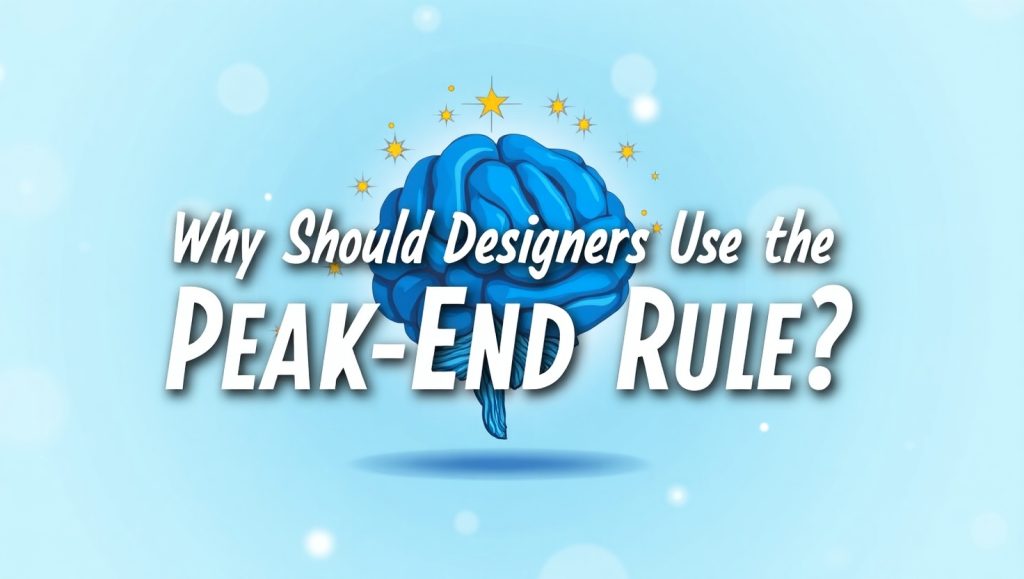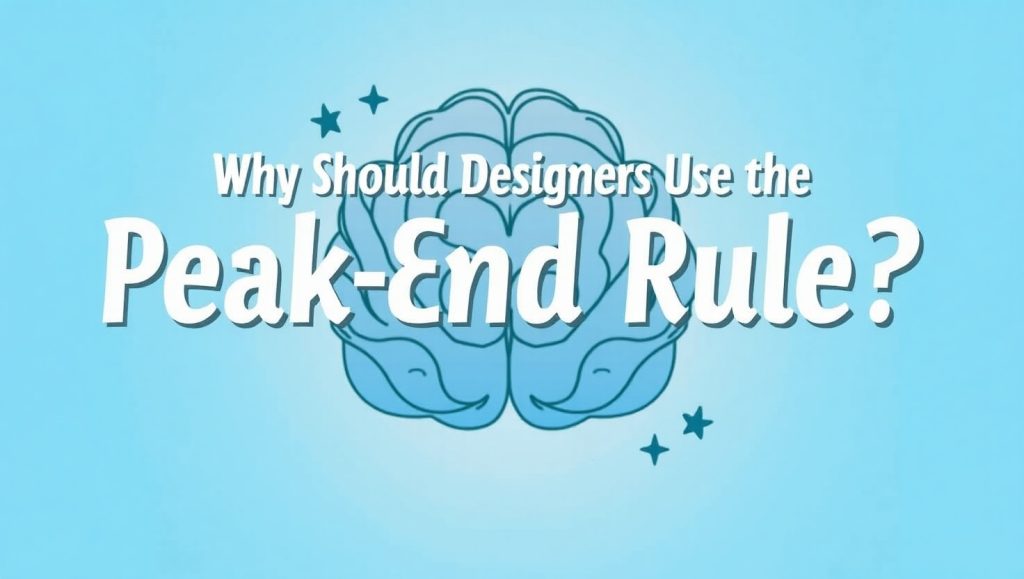The Peak-End Rule is an interesting psychological law that every designer should learn and leverage in practice. The Peak-End Rule states that the way people remember an experience is based on two moments: the most intense (the peak) and the last (the end) moment—not the whole experience. For designers, this is valuable information about a user’s experience that places emphasis on the moments that matter!
When designing a product, website, or service, it is easy to attempt to fix every little detail to perfection. However, the Peak-End Rule emphasizes users do not remember each step of the process equally. Users remember how they felt at the peak and how they felt at the end. If the users peak and end was positive, the user may even feel happier when looking back at the entire experience, even if some of the process was considered ‘okay’ (not good, not bad).
If we look at the checkout process on an e-commerce site, the peak moment could be the easy-to-use payment interface, while the end moment is the customers confirmation page that reassures them of their order. Focusing time and effort on peak and end experiences ensures positive lasting impressions.
Designers utilizing the peak-end rule to develop remarkable peaks and pleasurable endings are fostering experiences with which users want to engage again. For example, creating meaningful experience is not just about the usability of simple interactions, but about establishing emotional connections that create lasting impressions. The peak-end rule is vital to user experience design since establishing a connection with the user at an emotional level often determines whether a user is a one-time visitor or a repeat user.

How the Peak-End Rule Enhances User Experience
User experience isn’t just about usability or aesthetics – it’s also an emotion-driven experience. The Peak-End Rule tells us that people’s recollection of experience is determined by emotional peaks and, more importantly, the end.
When we use this rule, designers carve out intentional peaks of delight (or relief) which provide the emotional highs that leave the users feeling satisfied or pleased. These could be small touches such as a cheeky animation or an unexpected compliment attached to a feedback form or a simple, user-friendly success message.
The ending of the experience is also significant. An ending that has a positive outcome leaves your users feeling confident and appreciated. For example, a simple “thank-you, you’ve signed up!” page after completing onboarding, or an immediate follow-up email with useful information after a purchase can immediately amplify true overall satisfaction.
Designers can also develop user journey maps by describing key emotional peaks along the way and emphasizing strong endings of user experiences, identifying the potential where they should use their design efforts to elicit the most emotional impact in terms of overall experience. Implementing these types of considerations in your design can result in a richer user experience and are likely to prompt users to return to your experience and recommend it to others.
In practical terms, this principle aligns with interactive design best practices, helping teams focus on key moments that influence how users feel about the whole experience.
Implementing the Peak-End Rule in Web Design
Web design is an ideal domain to leverage the Peak-End Rule as it has various interactions and user touchpoints. The hardest part is figuring out which moments will end up being most memorable to a user and ensuring those moments are designed carefully.
The peak moments in web design may be when a user submits a form, successfully books an event, or receives immediate feedback via a feature to see if they have achieved a desired outcome. These moments can be designed to be delightful, whether through nice animations, uplifting messages, or a well-considered visual treat.
The end moment is just as important. It might be a confirmation page after a successful purchase, a message that might include their name and thanks them for using the site, or an approach that gently invites the user to explore even more content. If the end moment, be it a confirmation or otherwise, has a positive and unambiguous ending for users, it confirms to users they made the right decision, eases their mind, and engenders a mainly good feeling.
The loading speed and error handling in these moments must be perfect, because a user experiencing any kind of problem at peak or end moment can often ruin any positive feelings a user had before those moments.
This approach is common in high-quality user experience design projects that value emotional engagement as much as functionality, leading to higher user retention and satisfaction.
Emotional Design in Peak Moments
The moment at peak level become even more powerful when it involves an emotional design element, instilling a feeling (e.g. joy, relief, or surprise) creates enduring memories.
To create that feeling, designers are meticulous with color, typography, micro-interactions, and tone of voice choices. For example, presenting a warm acknowledgment for a successful task after a form submission can promote a feeling of accomplishment.
Animations or gentle sounds can also augment the emotional impact of an experience, to a degree, and only when in line with the expectations of a brand personality or it could feel very out of place.
Peak moments, when designers create patterns rich of and driven by the emotion, grow and strengthen a user’s relationship with a product, which encourage loyalty and referential recommendability.
Crafting Memorable Endings
The conclusion of an experience is the ultimate chance to let your users know they are valued. Designers must pay close attention that conclusions are explicit, rewarding, and unquestionable.
An explicit thank-you page with personalized messages and contingent next steps all contribute to a good ending. For instance, after an online purchase, users should be able to see their order details, customer support contact details, or ask other questions and also see follow-on engagement opportunities.
Conclusions must be smooth and frictionless. A confusing conclusion or abrupt ending can leave users frustrated and make a negative approach to the peak moments of positivity experienced in the experience.
Positive endings help create trust and lay the groundwork for ongoing relationships between users and brands.
Why the Peak-End Rule Matters for Conversion Rates

Conversion rates are largely influenced by users’ recollections about the interaction. The Peak-End Rule is a great way to influence recollection, as it directly determines these memories. Users are more satisfied and confident when peak and end moments are good which makes them likely to complete the desired action whether it is signing up, purchasing or sharing. Designers that consider these moments will decrease drop-offs while increasing completed actions.
For example, quick form validation at a peak moment with clear and reassuring confirmation page led to higher completing conversions. Users were also more likely to recommend and share their positive emotional experiences that will lead to organic growth of the product. Ultimately, by applying the Peak-End Rule, businesses create subsequently smoother, and streamlined funnels that convert better while fostering long-term loyalty.
Reducing Friction at Peak Moments
Friction during peak moments can destroy positive emotions quickly. Long forms, unclear instructions, or slow loading times create frustration that users remember vividly.
To reduce friction, designers simplify processes, provide instant feedback, and optimize speed. Clear, concise guidance eases user anxiety.
Removing these barriers ensures that peak moments remain delightful, increasing satisfaction and conversion potential.
Ending with Clarity and Gratitude
Clarity at the end of an experience helps users feel confident in their decision to engage or convert. Clear instructions, contact options, or thank-you notes make a strong positive impression.
After a purchase, a personalized thank-you message or a prompt for feedback can deepen user trust and encourage future engagement.
Showing gratitude makes users feel valued and respected, boosting overall brand perception and loyalty.
Conclusion
The Peak-End Rule is powerful tool for designers to create experiences that are memorable for their users to make lasting memories. By creating emotional peaks and positive endings, the user has greater satisfaction, engagement, and conversion.
By properly designing these moments of experience, the designers transcend simple aesthetics and functional design, and create meaningful experiences for users.
The Peak-End Rule is one of many UX principles and interactive design strategies that is related to user psychology, and provides another avenue for designers to create quality products that engrain emotional reactions into user experiences.
For those designers that want additional reading on user psychology, the Nielsen Norman Group covers the Peak-End Rule, and provides research and detail, alongside several other ideas of user psychology.
Most importantly, the Peak-End Rule isn’t only to refer to – it is a design element that you can implement to make memories that last, and provide an experience that users will remember, be loyal to, and ultimately, be successful.